Thank you for watching! We publish videos daily from Japan.
If you like our videos, please consider subscribing to our channel.
Youtube:
Twitter:
Instagram:
Youtube:
00:38 Wada, Minamiboso City
03:04 Chikura, Minamiboso City
19:15 Shirahama, Minamiboso City
About Chikura
Chikura (千倉町, Chikura-machi) was a town located in Awa District, Chiba Prefecture, Japan.
As of October 1, 2004, the town had an estimated population of 12,527 and a density of 342 persons per km². The total area was 36.64 km².
Chikura was located at southern end of Chiba Prefecture, at the southeast extremity of Bōsō Peninsula, facing the Pacific Ocean. The town had a temperate maritime climate with hot, humid summers and mild, cool winters.
Asai Village was created on April 1, 1889 within Asai District, which became part of Awa District from April 1, 1897. It became a town on June 25, 1900, and was renamed Chikura on October 1, 1920. The town expanded through merger with Nanaura, Takeda, and Chitose villages in 1954.
On March 20, 2006, Chikura, along with the towns of Maruyama, Shirahama, Tomiura, Tomiyama and Wada, and the village of Miyoshi (all from Awa District), was merged to create the city of Minamibōsō.
About Shirahama
Shirahama (白浜町, Shirahama-chō) was a town located in Awa District, Chiba Prefecture, Japan.
As of October 1, 2004, the town had an estimated population of 6,027 and a density of 353 persons per km². The total area was 17.07 km².
Shirahama was located at very southern end of Chiba Prefecture, at the southern extremity of Bōsō Peninsula, facing the Pacific Ocean. The town had a temperate maritime climate with hot, humid summers and mild, cool winters.
Shirahama Village was created on April 1, 1889 within Asai District, which became part of Awa District from April 1, 1897. It became a town on April 1, 1933.
On March 20, 2006, Shirahama, along with the towns of Chikura, Maruyama, Tomiura, Tomiyama and Wada, and the village of Miyoshi (all from Awa District), was merged to create the city of Minamibōsō.
Prior to the merger, Shirahama was known as Shirahama-machi in Japanese. Subsequently, it has become known as Shirahama-cho. Both “machi” and “cho” are written the same way in Japanese, but the different pronunciations convey the information that Shirahama is now a neighborhood within Minamibōsō rather than its own municipality.
Sightseeing Information
There are many spots and stories that make history feel, since ancient times called “the country of AWA.”
It is a fun trip to Minami Boso to visit while feeling a history that melts into the landscape.
Flower Calendar
Hiking and Cycling information
Educational Travel
Making Boshu uchiwa(round fan)
“Boshu uchiwa” which is characterized by a round pattern which is considered one of Japan’s three major uchiwas(Kyoto, Marugame).
You can experience the production of that uchiwa which is designated as a country’s traditional craftwork.
About Boshu Uchiwa (round fan)
With the high temperatures and similarly high humidity of Japanese summers, the uchiwa, or Japanese fan, has long been a vital summertime accessory. Uchiwa are even distributed on the streets as advertising tools when the temperature rises. As a common item in daily life, Chiba Prefecture’s one and only government-designated traditional craft, the Boshu uchiwa, is widely known across the nation.
The history of Boshu uchiwa can be traced back to the Edo Period (1603-1868). Back then, Boshu – now the southern region of Chiba Prefecture – was a producer of medake, a thin and supple form of bamboo that’s used as the main constituent of uchiwa. According to a document compiled in Chiba Prefecture in 1911, uchiwa production in the Boshu region started in the southern town of Nagomachi in 1877. In a document published in 1918, it’s mentioned that in 1884 a man called Iwaki Sogoro of Nagomachi invited craftsmen from Tokyo to come develop uchiwa production as the major industry of Chiba Prefecture’s southern region. Boshu uchiwa output reached its heyday around 1935, with annual production reaching roughly 8 million units. Today, it is crowned as one of the three major uchiwa brands of Japan, and is considered a representative brand of Japan on the whole
#StayHome and travel to Japan #WithMe
#iostoacasa


AloJapan.com